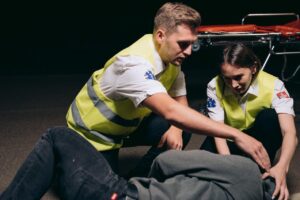Medical scenes can be a great way to explore the natural drama of life. These types of events frequently result in high emotions, life-and-death stakes, and even conflicts. However, it’s also vital to be authentic in your approach. When medical scenes strike a reader as realistic, it can pull them right out of the narrative, leaving you struggling to get them back into it.
Creating effective medical emergency scenes isn’t just about establishing a richly-described setting, with beeping electrocardiogram (ECG) equipment or malfunctioning vending machines. You also need to focus on making the characters and their actions as true to life as possible.
So, how can you go about this? Let’s explore a few things to consider.
Seek Expertise
Unless you are a medical professional, you’re unlikely to have many authentic insights into the professional side of medical emergencies. This is particularly important if you’re writing from the perspectives of doctors, nurses, and paramedics. Sure, many writers have been on the patient side of things, but this isn’t always the same as having the day-to-day technical knowledge to write convincing scenes.
So, what can you do? Wherever possible, seek a source of expertise. Look for medical professionals with experience in the situations you’re hoping to depict. Reach out to your immediate network and see if there are friends or family with connections that you can chat with. Even retired medical providers can give you some useful insights.
While authenticity is important, this doesn’t mean you have to overload your readers with dense medical jargon. That can certainly be off-putting. When you’re talking to experts, aim to get a good overall sense of the actions taken during procedures and the equipment being used. This ensures that you can paint the scene without leaning too heavily on accurate but ultimately meaningless technical data.

Write Empathetically
When you’re writing authentic medical emergencies, it’s essential to remember that professionals in these environments are people. Yes, they have technical knowledge and skills, but that isn’t the be-all and end-all of who they are. These are jobs in which professionals deal with pain, death, fear, and interpersonal connections every day. There’s a deep emotional component to the job that runs through everything they do. Therefore, you need to take an empathetic approach to writing about these characters.
Get into the emotional and practical mindset of professionals. You could consider the key components of thinking like a nurse to better understand their strengths, challenges, and coping mechanisms. For instance, while they are sensitive to patients’ pain and distress, their daily exposure to blood, wounds, and bodily fluids can make them less susceptible to shock in medical emergencies. Their regular handling of difficult circumstances may mean they’re always assessing the risks of a situation, even in their personal lives.
At the same time, these traits that make them effective professionals can also mean they experience too much emotional labor. They’re often putting the needs of others before their own. How they manage this and respond to it can make for great character depth and even be the source of some realistic flaws. Writing empathetically helps you avoid the tropes of the overworked nurse and dig a little deeper into the wider impact of their lives and mental wellness.
Consider Bystander Behavior
Medical professionals and patients are not the only people involved in medical emergency scenes. There are likely to be a range of bystanders such as members of the public at the scene of an accident or other patients in hospital waiting rooms. Being honest and curious about what their responses might be can add another layer of authenticity to your writing.
A good example here is bystanders at the scene of a medical emergency. It’s easy to fall into the trap of showing heroic and capable people who leap in to perform life-saving procedures until the ambulance arrives. This isn’t always accurate though. There are various emotional and practical reasons bystanders don’t attempt cardiopulmonary resuscitation (CPR). The burden of responsibility for someone’s life can be too overwhelming or they might be afraid of doing it wrong and causing more damage. Others simply misinterpret the situation as being less serious than it is.
This multitude of responses provides you with resources to make sure even minor characters ring true with your readers. Indeed, the nuances here can offer additional opportunities for drama and high emotion. Will a bystander with a fear of disease or infection be able to overcome this to save a life? What’s going through the head of a civilian with CPR training as they use their skills for the first time?
Conclusion
Achieving an authentic sense of realism is key to crafting impactful medical emergency scenes. This involves not just seeking out experts for research, but also delving into the emotions people are likely to exhibit. Authenticity doesn’t mean you need to forgo elements of fantasy or melodrama; instead, you just want a good foundation to build your fantastic fiction on.

Amanda Winstead is a writer from the Portland area with a background in communications and a passion for telling stories. Along with writing she enjoys traveling, reading, working out, and going to concerts. If you want to follow her writing journey, or even just say hi you can find her on Twitter.



 We love helping your growing in your writing career.
We love helping your growing in your writing career.

No Comments